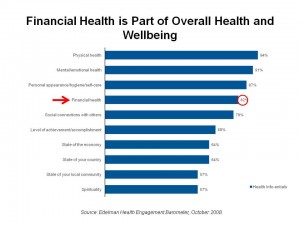 I tore out a two-page ad from the June 17, 2012, New York Times Magazine sponsored by Fidelity Investments with the headline, “Your genetic secrets may not be a secret much longer…and we see opportunity.” The ad copy went on to talk about the emerging era of personalized medicine and big data to help patients…and to be an investment growth area.
I tore out a two-page ad from the June 17, 2012, New York Times Magazine sponsored by Fidelity Investments with the headline, “Your genetic secrets may not be a secret much longer…and we see opportunity.” The ad copy went on to talk about the emerging era of personalized medicine and big data to help patients…and to be an investment growth area.
Fidelity has launched a video online as part of its ThinkingBig series at Fidelity.com/thinkingbig which talk about this complex issue.
Fidelity is onto something big here. In the first iteration of the Edelman Health Barometer survey, launched in 2008, we discovered a fascinating piece of data which found that health consumers around the world rank 4 issues tops in their personal definition of health and wellness:
- Physical health
- Mental and emotional health
- Physical appearance
- Financial health.
About 4 in 5 health citizens ranked financial health as integral to overall wellness, as the chart illustrates.
Fidelity’s campaign embraces this fact: that personalized medicine is part of the new health ecosystem, and represents both an opportunity for people’s physical health as well as long-term personal fiscal health.
Health Populi’s Hot Points: Since incorporating the aspect of financial health into my working definition of whole health, I have been tracking the financial services industry’s actions that address this issue. Fidelity is among the first to go this far, and I welcome the trend. Since the advent of The Great Recession of 2008, 1 in 2 U.S. health citizens have been self-rationing health care by splitting pills, not filling prescriptions, skipping dental check-ups, and postponing necessary medical tests. At the same time, R&D labs are commercializing new medical technologies that can do miracles.
There’s a chasm between what’s possible medically and technologically, how people are responding to the recession vis-à-vis their health, and what payors need to do to incorporate medical innovation into health plans. This requires the integration of both art and science, incorporating behavioral economics into value-based benefit design, and educating the public on both medical innovations and health literacy.
We’ll only realize the opportunity that Fidelity speaks to if we get all health stakeholders on the same page. This requires collaboration, transparency, and engaging communication. It’s great to see Fidelity on this path.
 I tore out a two-page ad from the June 17, 2012, New York Times Magazine sponsored by Fidelity Investments with the headline, “Your genetic secrets may not be a secret much longer…and we see opportunity.” The ad copy went on to talk about the emerging era of personalized medicine and big data to help patients…and to be an investment growth area.
I tore out a two-page ad from the June 17, 2012, New York Times Magazine sponsored by Fidelity Investments with the headline, “Your genetic secrets may not be a secret much longer…and we see opportunity.” The ad copy went on to talk about the emerging era of personalized medicine and big data to help patients…and to be an investment growth area.




 Grateful to Gregg Malkary for inviting me to join his podcast
Grateful to Gregg Malkary for inviting me to join his podcast  This conversation with Lynn Hanessian, chief strategist at Edelman, rings truer in today's context than on the day we recorded it. We're
This conversation with Lynn Hanessian, chief strategist at Edelman, rings truer in today's context than on the day we recorded it. We're